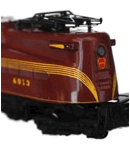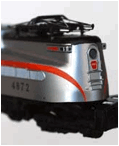Pennsylvania’s Congressional, 1952-1967
Fred Klein, 2013
The
Pennsylvania railroad PRR was the largest in the US by revenue and traffic, and
called itself the standard railroad of the world. The Congressional was the
premier day train connecting New York City with Washington DC. It catered to
businessmen, politicians and government people as well as travelers in the
northeast corridor. Various trains covered this route almost hourly through the
day, but the Congressional featured first class parlor cars for an upscale
clientele. The trains made the run in less than 4 hours with 7 stops.
The PRR
began passenger service from New York City to Washington in 1885 that
eventually spawned the "Congressional Limited Express." In the 1920s,
all-steel heavyweight cars were the norm. In January 1935 the line was
electrified and the Congressionals were the first
train to get the new GG1 electric locomotives. Meanwhile, the competition
including the Reading Railroad’s Crusader (1937) was upgrading to streamliners
while the Pennsylvania ran stodgy heavyweight trains. In 1952, PRR served the
New York to Washington route with new 18-car streamliners called the “Morning Congressional” and “Afternoon Congressional”. Two trainsets were bought for the Congressionals.
They departed New York and Washington in the early morning, were turned on
arrival, and arrived back in the evening. Another streamliner introduced the
same year, also with new Budd cars, was the Senator. It ran from Washington to
Boston with the segment north of New York City carried by the New York and New
Haven railroad. NY&NH coaches were used in the Senator in addition to PRR
coaches. There was no need for a sleeper on a day train, although parlor cars
offered first class service and business meeting rooms.
The new
Budd cars were stainless steel with a tuscan
stripe in the letterboard. Six of the GG1 electric
locomotives (that dated from 1936) were painted Tuscan in 1952 for the
Congressional and Senator to match the stripe on the passenger cars. Three more
GG1s were painted silver with a wide red stripe and large keystone herald in
1955 for these trains.

A Pennsylvania Railroad advertisement from
1952 showing the new train outside Washington DC.

The Congressional train in October 1965.

The
Senator train crossing the Susquehana River bridge at Perrysville Maryland circa 1952. If there are any
New York & New Haven Railroad coaches in the consist,
they are obscured by the bridge. The appearance of the Senator and Congressionals were very similar, though the Senator used
New Haven locomotives north of New York. Photo by Lawrence
Williams.
Models of
an exact Congressional train have not been made in N scale, but Concor makes a series of Budd passenger cars whose
prototypes were the Budd cars of the 1949 California Zephyr and other
Burlington cars. The Concor cars are from the same
era as the 1952 congressional and each car type (with some substitutions) has an
approximate model in the Concor lineup. The window
placements may not match the PRR cars exactly, but the model paint scheme is
for the Congressional and Senator. Of course the factory painted car numbers
are often not prototypical. The Concor Budd coach is
a near match to the Pennsylvania P82 60-seat coach. The Concor
“chair car” with window dividers approximates the reclining seat PRR coaches. The
parlor cars are very similar to the PRR prototype. It is thus possible to make
a beautiful train with a prototypical consist with factory-painted model cars.
This
afternoon Congressional consist was published by Robert Wayner
in Passenger train consists 1923-1973,
page 76, for a train arriving at Newark NJ on August 29, 1961. A
coffee-shop-tavern car was within the coach section when the train was
launched, but apparently it was not in the train in 1961.
Table of prototype and model consists
|
prototype car |
prototype # |
maker |
model car |
model # |
year |
proto? |
|
GG1
electric locomotive |
PRR
4927 |
Kato |
GG1 locomotive (tuscan), or |
PRR 4913 |
1952 |
yes |
|
GG1
electric locomotive |
Kato-Kobo |
GG1 locomotive (silver) |
PRR 4872 |
1955 |
yes |
|
|
Baggage
(extra) |
PRR |
Hellgate |
60' B60b baggage car |
PRR 5868 |
1925 |
yes |
|
6
sect-6 rmt-4 dbr |
CN
Green Lane |
Rapido |
Duplex
sleeper |
CN
Emperor |
1954 |
yes |
|
Coach
(P-85-H) |
PRR
1677 |
Con
cor |
Coach,
chair car |
PRR
4041 |
1951 |
yes |
|
Coach |
PRR
1632 |
Con
cor |
Coach,
chair car |
PRR
4041 |
1951 |
yes |
|
Coach |
PRR
1667 |
Con
cor |
Coach |
PRR
4049 |
1951 |
close |
|
Coach |
PRR
1571 |
Con
cor |
Coach |
PRR
4049 |
1951 |
close |
|
Coach |
PRR
1594 |
Con
cor |
Coach |
PRR
4049 |
1951 |
close |
|
Diner |
PRR
4626 |
Con
cor |
Coach,
chair car |
PRR
4041 |
1952 |
stand
in |
|
Kitchen-diner |
PRR
4627 |
Con
cor |
Budd
Diner |
PRR
4500 |
1952 |
stand
in |
|
Parlor |
PRR
General Lafayette |
Con
cor |
Parlor
|
PRR
Molly Pitcher |
1952 |
close |
|
Parlor |
PRR
Johns Hopkins |
Con
cor |
Parlor
|
PRR
Nathan Hale |
1952 |
close |
|
Parlor |
PRR
Johan Printz |
Con
cor |
Parlor
|
PRR
Molly Pitcher |
1952 |
close |
|
Parlor |
PRR
Casimir Pulaski |
Con
cor |
Parlor
|
PRR
Nathan Hale |
1952 |
close |
|
Parlor-7
conference rm |
PRR
Mattias Baldwin |
Con
cor |
10-6
sleeper |
PRR
4049 |
1952 |
stand
in |
|
Observation-2
draw-1 dbr |
Wm Wallace Atterbury |
Con
cor |
Observation
Budd 1952 |
PRR
1126 |
1952 |
stand
in |
Alternative Power (post 1955)

In
1955, three GG1s were painted silver to add sparkle to some of the
Congressional and Senator trains. The large keystone herald and wide stripe
were introduced in the late 50s.
Power and ferried sleeper


The GG1
locomotive that normally powered the Congressional after 1952 was one of the
six that were painted in Tuscan to complement the Tuscan stripe on the
passenger cars. The model is a factory painted Kato locomotive. Speed was
essential for the Congressional and it normally did not carry baggage cars for
making express deliveries along the way. No checked baggage was taken on the
Congressional. If it did need a baggage car for end-to-end use, it would likely
be one of the Pennsylvania’s B60b 60’ cars. The baggage car is a Hellgate Models kit. Wayner’s
consist lists a Canadian National sleeper being ferried from Washington to New
York. It could be a dead head car or one that had special convention attendees,
for example. The duplex sleeper is a factory painted Rapido
model.
Coach section

The train consist has 5 coach cars. I use two different
types of coach cars, one with window dividers and one without.
Diner, lounge and parlor cars

The food
cars were the pair PRR 4626 and 4627, with a dining room in the first car and
the kitchen and second dining area in the second car. The cars were not
articulated but were always coupled together. I do not have a model of these
cars, but substitute a coach for the diner and Budd diner car with kitchen and
a smaller seating area for the second car. The Congressional consist then had
four or five parlor cars. Each parlor car also had a drawing room.
Parlor cars, meeting room car and observation lounge

The
four parlor cars were for passengers travelling first class. They
were followed by a 7-conference room/drawing room car whose rooms could
be rented for business meetings. A 10-6 sleeping car is a stand in for this
unusual car. The last car had two drawing rooms, a double bedroom and an
observation lounge. The prototype car had a squarish
end, but the stand-in Concor model car has a round
end.






References
Schaefer,
Mike and Joe Welsh, Classic American
Streamliners, Motorbooks International, 1997.
Schaefer,
Mike and Brian Solomon, Pennsylvania
Railroad, Voyageur Press, 2009.
Wayner, Robert, Passenger train consists 1923-1973, Wayner publications.
http://www.streamlinerschedules.com/concourse/track3/congressionals195212.html
http://www.streamlinerschedules.com/concourse/track3/extras/ra19520317congressionals.pdf
BACK TO THE PAGE OF
PASSENGER TRAINS